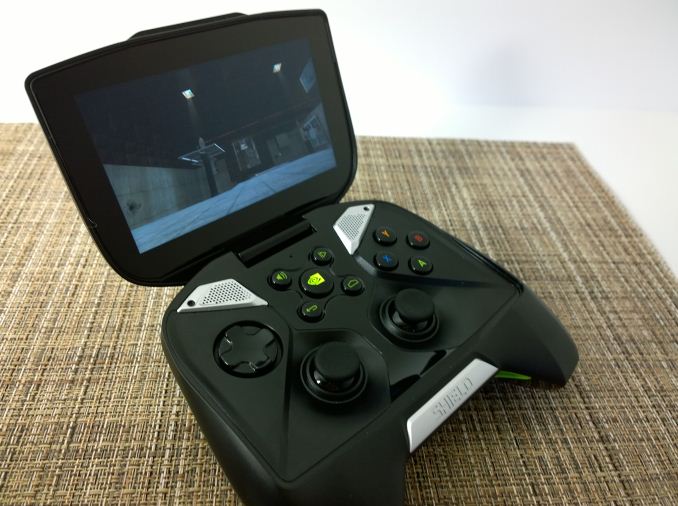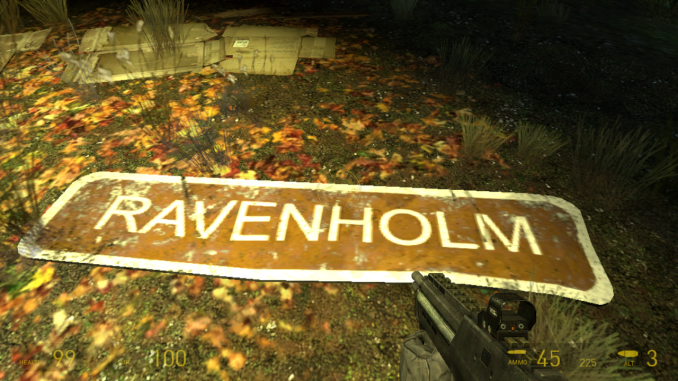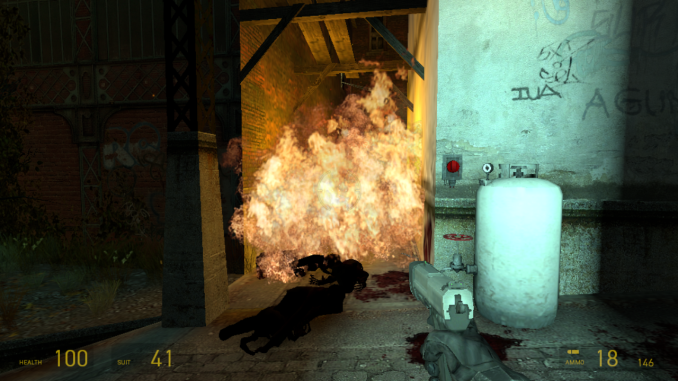Some Thoughts on Half-Life 2 and Portal on Shield
by Joshua Ho on May 22, 2014 10:35 PM EST- Posted in
- Smartphones
- Mobile
- Tablets
- Shield
- NVIDIA

If you talked to me seven years ago, the concept of phone games beyond Snake and basic flash games would've been beyond me. That wasn’t really on my mind, especially because playing games like Battlefield 2 effectively required a desktop. I did try it on a Dell XPS M170, with an Nvidia 7800 GTX graphics card, 1 GB of RAM, and a Pentium M processor, but even then, it was no guarantee that it would load the game consistently. Crashes to desktop were common because of the RAM requirements, and hitting the page file would cause frustrating freezes. Of course, things have completely changed since then. Mobile became one of the fastest growing sectors in the tech industry, 40-60mm thick, 14 pound laptops were no longer necessary to play games at acceptable IQ/FPS levels, and the slate-style smartphone has gone from distant curiosity to everyday necessity.
So the port of Half-Life 2 and Portal to the Shield was interesting, because I’ve seen the sheer breadth of experiences that Source can provide, from Resistance and Liberation to Nightmare House 2. Nvidia has stated that Half Life 2 on Android is a port of the Linux version with OpenGL support to OpenGL ES, and based upon a casual playthrough of both Half Life 2 and Portal, it’s not immediately obvious that there are any issues with the engine port itself. In fact, it runs quite well. When immersed in playing the game, the experience is incredible, especially compared to the experience that one usually gets on handheld consoles like the PS Vita and 3DS. While I was concerned that the control scheme would be difficult to adapt to as a PC gamer, it turns out that with auto-aim and some other compensation mechanisms that gameplay is perfectly workable. The one issue that I did have was targeting things like headcrabs in mid-air, as pixel-precise pointing still isn’t quite there for joystick control systems. Battery life was also great. I managed to go around four hours of nonstop gaming at a mid-level of brightness, although this is an extremely rough rule and can vary greatly. I hope to get more precise data on this soon.
Of course, the bigger question is how well it actually performs. While timedemo functionality can’t be accessed, video settings are locked out, and there’s no console access like in the PC versions, it’s still possible to gauge the approximate experience. Based upon a quick playthrough of Ravenholm, I managed to take a closer look at the FPS instead of relying purely upon subjective judgment. It turns out that there’s a pretty even distribution of FPS across the board from 20 FPS to 60 FPS. The median FPS was 43, and overall I’d say that it’s quite accurate, as in less intensive scenes it will stay capped at 60 but anything with effects such as fire and explosions will often cause the gameplay to stutter noticeably, as in the scene above. Portal was similar, but due to the relatively simple level design FPS remained higher in general. Overall, it appears that the CPU usually is only at around 50% utilization throughout the game, which is indicative that either the GPU is the limiting factor in performance of this game or that the engine is not well-threaded for the port. There was the possibility of thermal throttling, but unlikely because exhaust air temperatures weren’t hot enough for concern. Unfortunately, no data on battery voltage nor temperature is given by the Shield. Ultimately, while this is helpful information for someone that wants to buy the game, the real question is how well IQ and performance compare to PCs, and will require further investigation to get a rough idea of how well modern ARM SoCs compare with CPUs and GPUs from the 65-90nm era.












40 Comments
View All Comments
Impulses - Friday, May 23, 2014 - link
Because when most developers design for mobile devices in general they design for the lowest common denominator, I don't see an age where we have triple AAA titles that need a Shield in order to run properly (like you might see for PC)... So the whole thing is bound to remain more niche, it's sorta like the Nexus platform of mobile gaming, nice showcase but that's it.testbug00 - Friday, May 23, 2014 - link
SHIELD has sold under 10K units... it might have shipped more due to Nvidia giving away a ton at GDC. I was so close to getting time off to go also :(testbug00 - Friday, May 23, 2014 - link
the controller. That makes is so much better to play those games... I imagine. Not to mention that there will be far more games it can play.Playing them on phones (in my experience) is very draining on the hands due to how you have to hold the device. I would say I have tried it on the SHIELD, but, given the specifications (read: the 720p screen, and, only being 5" screen) it costs to much for me to justify it :S
anandreader106 - Friday, May 23, 2014 - link
Try using a Moga Pro Controller. Controller wise, it is very similar and has the added benefit of charging your phone as you play. It's a far cheaper solution to quality mobile gaming if you already have a great phone.JeffFlanagan - Friday, May 23, 2014 - link
I have a $20 bit of plastic and rubber called a GameKlip that connects a PS3 controller to my old Android phone. This creates gaming hardware similar to shield, where I can play a ton of emulated arcade and console games. I still mostly game on a powerful PC.Guspaz - Friday, May 23, 2014 - link
Shield is uncomfortable to play for extended periods of time. While it does look like a game controller, it's bulkier, much heavier, and has a few ergonomic issues that are unpleasant in the long run.Personally, I see Shield as an interesting proof-of-concept that isn't all that practical in real life, and if they make sufficient improvements for Shield 2, they could really have something on their hands.
kpxgq - Friday, May 23, 2014 - link
for me as a current shield owner, the appeal of it is the fact that it is a portable and affordable device with:- high end SoC for sub $200
- Miracast, HDMI, microSD
- long battery life
- rugged design
The shield is still too large to be considered a true portable device IMHO... my galaxy S4 has enough power and versatility and is actually on me 99% of the time. What I like the shield for is that I can grab it, plug in a pico projector and have a completely wireless and battery operated mobile home theater. If I want to play my PC games on my big screen HDTV downstairs, instead of lugging over my desktop or finding a 100ft HDMI cable, I can just plug my Shield into the TV and have wireless streaming using either the built in gamepad or USB keyboard/mouse.. After gaming, I can just load up XBMC or the netflix app to play movies on the TV, the possibilities are endless. I cant do those things with most phones/tablets on the market right now because:
- they are too expensive compared to the Shield in terms of performance
- require adapters or wireless video adapters to stream video
- most dont have microSD
- most require a bluetooth gamepad/input device for any sort of non touch related gaming
Jumangi - Saturday, May 24, 2014 - link
The only reason this game happened was Nvidia did the port. Shield will never be more than a tech demo platform. You'll never see something like Assassins Creed on it.HisDivineOrder - Friday, May 23, 2014 - link
This is the reason developers will eventually go OpenGL.Not because it's BETTER technically than DirectX (yet?), but because it will become increasingly more important for publishers to see games being released across a wide variety of devices including Windows PC's, consoles, smartphones, and tablets.
The easiest way to do that is to use a cross-compatible platform and the only one that fits the bill is OpenGL (and ES).
DirectX is only on Microsoft platforms. Mantle is only on very specific hardware and currently only on Windows.
Which leaves OpenGL.
More than anything, this little experiment on the part of nVidia and Valve works because it emphasizes this fact to anyone watching. I imagine this is as much about Valve saying, "See. You're not just porting your games to OpenGL for SteamOS and Linux. You're porting them for Android devices of all kinds, too."
And now they can go and look and say, "You know. They're right. This is WAY bigger than just SteamOS support."
nVidia likes it because it gives their SHIELD devices a nice bit of recognition as a portable gaming platform, but also because any OpenGL resurgence is a setback to Mantle.
Stochastic - Friday, May 23, 2014 - link
Good insight, I hadn't considered things from that angle.